This is a preprint.
Deep immune profiling of COVID-19 patients reveals patient heterogeneity and distinct immunotypes with implications for therapeutic interventions
- PMID: 32511371
- PMCID: PMC7263500
- DOI: 10.1101/2020.05.20.106401
Deep immune profiling of COVID-19 patients reveals patient heterogeneity and distinct immunotypes with implications for therapeutic interventions
Update in
-
Deep immune profiling of COVID-19 patients reveals distinct immunotypes with therapeutic implications.Science. 2020 Sep 4;369(6508):eabc8511. doi: 10.1126/science.abc8511. Epub 2020 Jul 15. Science. 2020. PMID: 32669297 Free PMC article.
Abstract
COVID-19 has become a global pandemic. Immune dysregulation has been implicated, but immune responses remain poorly understood. We analyzed 71 COVID-19 patients compared to recovered and healthy subjects using high dimensional cytometry. Integrated analysis of ~200 immune and >30 clinical features revealed activation of T cell and B cell subsets, but only in some patients. A subgroup of patients had T cell activation characteristic of acute viral infection and plasmablast responses could reach >30% of circulating B cells. However, another subgroup had lymphocyte activation comparable to uninfected subjects. Stable versus dynamic immunological signatures were identified and linked to trajectories of disease severity change. These analyses identified three "immunotypes" associated with poor clinical trajectories versus improving health. These immunotypes may have implications for therapeutics and vaccines.
Figures
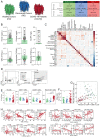
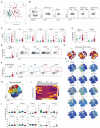
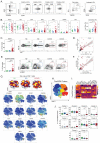
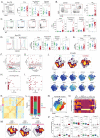

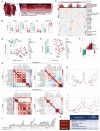
References
-
- Iype E., Gulati S., Understanding the asymmetric spread and case fatality rate (CFR) for COVID-19 among countries. medRxiv (2020) (available at https://www.medrxiv.org/content/10.1101/2020.04.21.20073791v1.abstract). - DOI
-
- Moore J. B., June C. H., Cytokine release syndrome in severe COVID-19. Science. 368, 473–474 (2020). - PubMed
-
- Vabret N., Britton G. J., Gruber C., Hegde S., Kim J., Kuksin M., Levantovsky R., Malle L., Moreira A., Park M. D., Pia L., Risson E., Saffern M., Salomé B., Selvan M. E., Spindler M. P., Tan J., van der Heide V., Gregory J. K., Alexandropoulos K., Bhardwaj N., Brown B. D., Greenbaum B., Gümüş Z. H., Homann D., Horowitz A., Kamphorst A. O., Curotto de Lafaille M. A., Mehandru S., Merad M., Samstein R. M., Immunology of COVID-19: current state of the science. Immunity (2020), doi: 10.1016/j.immuni.2020.05.002 - DOI - PMC - PubMed
-
- Weiskopf D., Schmitz K. S., Raadsen M. P., Grifoni A., Okba N. M. A., Endeman H., van den Akker J. P. C., Molenkamp R., Koopmans M. P. G., van Gorp E. C. M., Others, Phenotype of SARS-CoV-2-specific T-cells in COVID-19 patients with acute respiratory distress syndrome. medRxiv (2020) (available at https://www.medrxiv.org/content/10.1101/2020.04.11.20062349v1.abstract). - DOI - PMC - PubMed
Publication types
Grants and funding
LinkOut - more resources
Full Text Sources
Other Literature Sources
